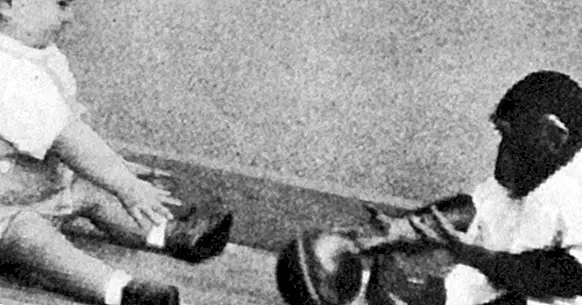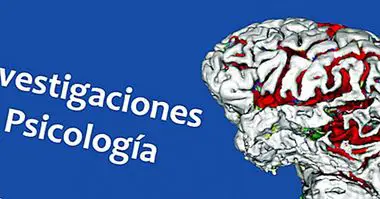Gua, the chimpanzee raised as a human baby
The history of psychology is full of unusual studies and experiments that would hardly be justified or would be possible at present. The reason is that many of these studies were based on experimentation with young children, adolescents or people with some type of mental or psychiatric disorder, all of them unable to decide or understand the effects of this.
One of these experiments was that of the chimpanzee Gua, performed by the psychologist W. N. Kellogg . This is an investigation about behavior and learning in which Gua was raised for months in a family, with the intention of checking if the chimpanzee could be educated like the rest of the children.
- Related article: "The incredible case of the gorilla that was raised as a child more"
As father and daughter: Chimpanzee Gua and W. N. Kellogg
In the 1930s, Winthrop N. Kellogg, a psychologist and professor at Columbia University, specializing in the processes of conditioning, learning and human behavior, set out to investigate the differences between animals and humans in terms of learning and behavior .
Kellogg adopted a two-month-old chimpanzee female and introduced her to her home with the intention of educating her in the same way that she did with her son Donald, who at the time was not yet one year old. For several months, Kellog raised them as if they were brothers , dedicating the same attention, affection and care to each of them with the aim of contemplating and analyzing the evolution and learning of the two.
The animal chosen for the study was awarded in the name of Gua and, without her knowing it, its objective was to reveal at what point some kind of distinction between the processes and advances in learning between an animal and a human began to begin.
The result: something unexpected
After nine months of coexistence, the results were not at all as expected by Kellogg, since, briefly, Gua ended up "humanizing" to the point of learning more quickly and effectively than his son , and the little one ended up developing behaviors typical of a chimpanzee like trying all things with his mouth or emitting howls and grunts like Gua.
Such was the degree of learning of the child that a large part of the idioms and habits that he had learned from Gua would remain intact throughout his life.
The product of this investigation materialized with the work The ape and the child, published in 1931 and which was not exempt from criticism and controversy. In his text, Kellogg details each and every one of the learning activities and games he did with both, as well as the effects they had on the children.
As a result, the American psychologist received very tenacious and ruthless criticisms that they accused him of having subjected his son and the animal to an experiment that would leave a mark on both forever. The impact of the criticism took deep root in Kellogg, who ended up acknowledging that he had been wrong.
- You may be interested: "Is our species more intelligent than the Neanderthals?"
How was the experiment between breeding and baby developed?
At the beginning of the investigation, it focused on collecting data about the physical state of both Gua and little Donald. Both Kellogg and his wife, accompanied by a group of researchers, collected data such as weight, blood pressure or reflexes, then start with activities and tests related to learning .
Over the next 9 months, Kellogg and his wife raised Gua in the same way that they raised their son, as if they were brothers. Recording the data in filming and thoroughly describing each and every one of the changes or advances in each one of the small ones.
The data obtained by Kellogg and his team focused on aspects such as memory, the ability to draw, vocalization or language, manual dexterity, locomotion, problem solving, reactions of fear and fear, obedience and even the ability to respond to tickle
What was the results?
During the time the study lasted, Kellogg observed how Gua developed a fascinating ability to adapt to a human environment , to the point of following orders and following guidelines much better than his "brother" Donald. Other of the many behaviors learned by Gua were related to the capacity to ask for a person, to kiss other people, and she even learned to eat for herself in the same way as humans or to bathe herself.
On the other hand, Donald possessed a characteristic feature: he was much better imitator.While Gua in the advantaged student, who was able to discover before Donald the functions and utilities of the objects and showed a better comprehension of the different games and activities that they carried out, the little human was only dedicated to imitate or reproduce what the chimpanzee did.
As a result, little Donald also began to imitate some of Gua's gestures, behavior and language, using grunts, snoring and animal noises and experiencing a significant delay in language development and remarkable communication difficulties. This is one of the reasons why, despite Gua's advances, Kellogg decided to stop the experiment after nine months of testing. After this time, separated the two "brothers" and Gua was returned to the zoo of Orange Park, where it was extracted and which could not adapt, dying the following year.
As for Donald, he was already 19 months old at the end of the experiment and yet he was only able to express a small number of words, while any child of his age should have at least a repertoire of fifty and be able to start forming phrases and sentences. Fortunately, he later compensated for this disadvantage, and even completed university studies.
What conclusions were drawn from this study?
In terms of learning processes, Kellogg concluded that, at least during the childhood stage, children are highly influenced and that in his first years of life his abilities of reason and intelligence can be comparable to those of an animal of intelligence of the characteristics comparable to those of a chimpanzee.
However, later these paths are separated, human beings being able to develop a level of intelligence and much higher abilities.
Regarding the intellectual development of the chimpanzee, the Kellogg methods may reflect that these, in the first months of life, have the ability to develop a language analogous to the human, although are unable to speak . In the same way, although these are skilled in making simple tools, there is a huge difference in the capacity of ideation between chimpanzees and humans.



















